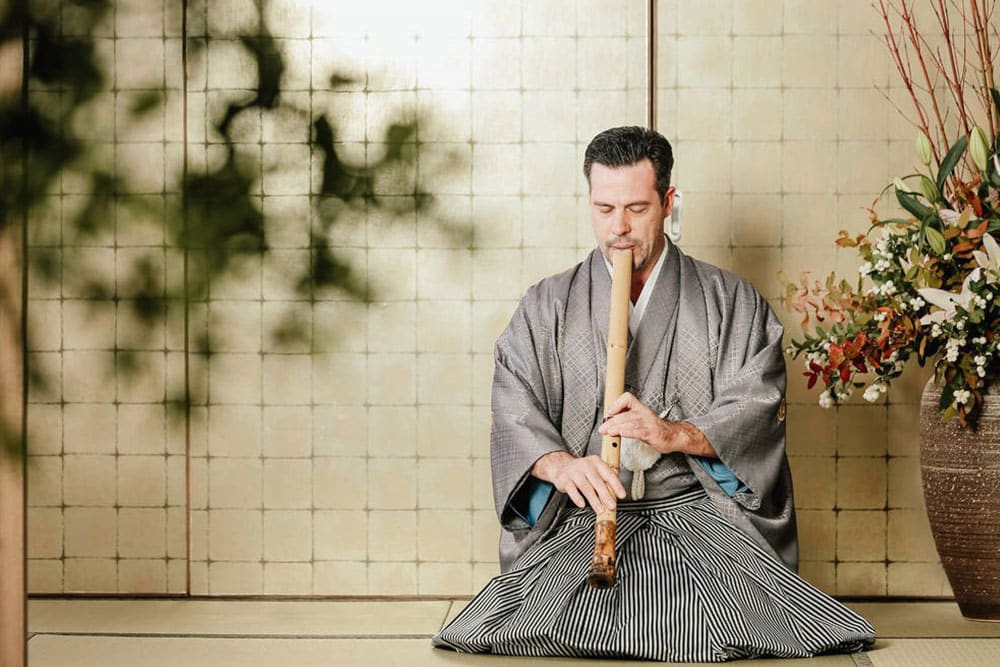
01 Mar How to Play The Shakuhachi Flute
Have you ever wanted to play a bamboo flute? Well, you’ve come to the right place. Whether you’re new to the shakuhachi Japanese flute or not, we can help you gain the knowledge and skills needed to excel on the shakuhachi. Continue reading to learn how to play a shakuhachi.
Introduction to the Shakuhachi
The shakuhachi embodies centuries of craftsmanship and tradition, producing hauntingly beautiful melodies that resonate with the soul. Ancient Zen Buddhist monks used the shakuhachi to help enhance their meditation and spiritual enlightenment.
Understanding the Parts of the Shakuhachi
From the utaguchi (mouthpiece) to the root end, each component of the shakuhachi serves a distinct purpose in shaping the instrument’s sound. It also features seven finger holes, which dictate the pitch of each note that is played. You will also need to pay attention to the position of the nodes, which influence the flute’s resonance.
Proper Posture and Holding Technique
Correct posture and holding technique allow you to achieve optimal performance on the shakuhachi. Start by sitting upright with your back straight and relaxe your shoulders. Next, cradle the flute in your left hand so that your right hand can move freely up and down the length of the shakuhachi. Maintain a slight angle between the flute and your body to facilitate airflow and enhance sound projection.
Breathing Techniques for Shakuhachi Playing
If you want to learn how to play a shakuhachi well, you must first cultivate a deep, controlled breath. Your breath should engage your diaphragm and whole abdomen to allow the air to flow smoothly and evenly through the flute. Feel free to experiment with various breathing techniques, such as long tones and circular breathing, to expand your lung capacity and sustain notes on the shakuhachi.
Producing Sound: Embouchure and Lip Positioning
Mastering the embouchure, or mouth position, is the key to producing a rich and vibrant sound on the shakuhachi. Position your lips and jaw to form a relaxed yet firm seal around the utaguchi, focusing the air stream towards the inner edge to initiate vibrations. Experiment with different lip positions and angles to achieve your desired tone quality and timbre.
Basic Finger Placement and Hand Positioning
The shakuhachi has finger holes, and each finger should have a relaxed yet supple grip on the flute. Practice transitioning between notes to enhance your fluency and musical expression as you continue to learn how to play shakuhachi flute.
Playing the Fundamental Notes: Ro, Tsu, Re, Chi, Ri
The fundamental notes of the traditional scale are Ro, Tsu, Re, Chi, and Ri. As you play this scale, focus on producing each pitch with clarity and consistency, paying attention to intonation and tone quality on the shakuhachi.
Practicing Scales and Exercises for Technique Development
Have daily practice sessions on the shakuhachi that include the scales, arpeggios, and technical exercises designed to strengthen your technique and dexterity. Start off slowly and gradually increase the tempo as you gain confidence and proficiency on the instrument. As you get better, you can also incorporate dynamic (volume) variations, articulation patterns, and rhythmic motifs to enhance your musicality and expressiveness.
Exploring Traditional Shakuhachi Repertoire
Immerse yourself in the rich and diverse repertoire of shakuhachi music by studying recordings, transcriptions, and notation scores. Listen to ancient honkyoku pieces, modern compositions, and folk melodies to gain more insight into the cultural heritage and artistic expression of the shakuhachi. Doing these things will quickly deepen your appreciation and understanding of this timeless art form.
Introduction to Traditional Japanese Music Notation: Kinko and Tozan
Traditional Japanese music notation systems, such as Kinko and Tozan, are used to transcribe shakuhachi music. Learn to interpret its symbols, characters, and markings that convey pitch, rhythm, and articulation. Understaning the musical notation system they use can allow you to recreate the nuances and subtleties of each composition more accurately.
The Role of a Shakuhachi Sensei
Lastly, consider getting a qualified shakuhachi sensei or teacher to accelerate your learning on this instrument. A knowledgeable instructor can offer personalized instruction, feedback, and guidance that is tailored to your needs and goals. You can also join workshops, seminars, and masterclasses to expand your knowledge and connect with fellow enthusiasts in the community.
Remember to approach each practice session with patience, perseverance, and an open heart. Embrace the challenges and discoveries that lie ahead, and savor the joy of making music on a shakuhachi. Gambatte kudasai!
Click here if you are interested in taking beginner-friendly shakuhachi lessons from Shawn


